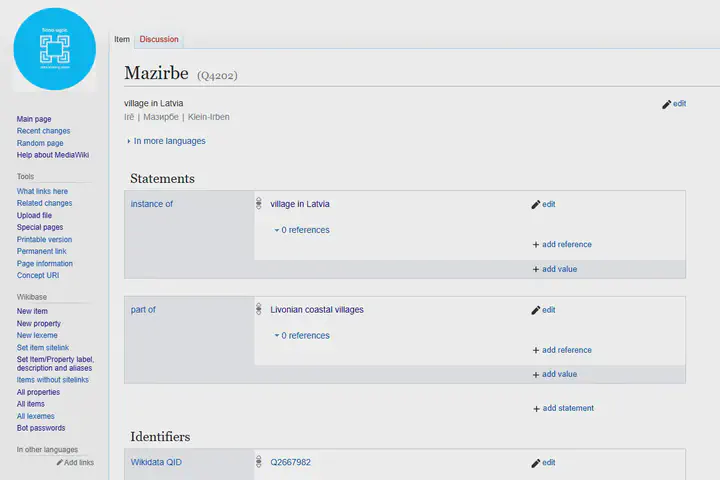Metadata Groundhog Day: What a Moribound Language Can Teach Spotify and Shopify
Data description and data access points

And if you want to fix these errors, you may find that you are back to the Data Sisyphus.
When you build systems in the cloud, or in your local architecture, at one point you will realise that naming things — places, people, products — or updating their whereabouts is probably the most time-consuming, most expensive, and most error-prone workflow.
In this blogpost, we want to talk about what seems like the easiest part of a location: the name of the city, town, or village.
Mazirbe Is Missing Again
We recently built a multilingual gazetteer — essentially a reconciled database of place names — for a tiny stretch of the Livonian coast in Latvia. At first glance, this might seem like a project rooted deeply in the digital humanities.
But here’s the twist: the very same problems we tackled here are the ones plaguing the music industry, global e-commerce platforms, and enterprise software stacks.
 👉 [Familiar with RDF: see in TTL](https://reprexbase.eu/fu/Special:EntityData/Q4429.ttl); Klein-Irben will be near Gross-Irben, and Irē is almost Īra!](/media/png/identifiers/geonames_lielirbe_2x1_hu2f3d53746350179bbf98c0f697c64400_111140_32eeb639bc704a3ad38976cf6b4a1e06.webp)
Mazirbe is a small, big place. It definitely exists, and it is the cultural center of a small nation: the Livonians. Yet, when you are looking for clothing, music, or photographs that should come from Mazirbe in a relevant database, you often find nothing. Not even the place.
But Mazirbe exists!
Depending on the record, it might appear as:
- Mazirbe (Latvian) • Irē (Livonian) • Мазирбе (Russian) • Klein-Irben (German) • Suur-Irben (Finnish-German hybrid) • Мазирбе (Russian) • Mazirbė (Lithuanian)
](/media/webp/identifiers/old_map_of_courland_hue01bb2cd2f71c02c57a3f3e8212ca966_977008_0c287770dd041e1a97efbed60791a980.webp)
This kind of variation isn’t just a cultural footnote — it breaks databases, mismatches search results, and silently corrupts analytics.
If you’re in music metadata, this is your “JAY Z” vs. “Jay-Z” vs. “Shawn Carter” problem.
If you’re in e-commerce, it’s “Red Crewneck XXL” vs. “Crewneck, crimson, 2XL”.
Same data structure. Same unresolved chaos.
A Gazetteer That Works Like Real Life
We created a semantic, multilingual, multiscript gazetteer for the Livonian coast. Each place entry includes:
All known name variants across time, languages, and scripts
Structured links to global authority services (Wikidata, VIAF, GeoNames)
Canonical IDs, multilingual labels, and machine-readable formats (RDF, TTL, etc.)
Context about administrative boundaries, historical changes, and source provenance
Try us:
 👉 [Familiar with RDF: see in TTL](https://reprexbase.eu/fu/Special:EntityData/Q4202.ttl)](/media/png/identifiers/fuds_mazirbe_2x1_hue147fb84f0dcec7ccc29241d53d4804a_93374_a8f87b64beac38f2fa0357c52941c885.webp)
We published it using Wikibase — the same technology that powers Wikidata. It’s not just a spreadsheet; it’s a small, dynamic knowledge graph.
And we also put it into BlazeGraph, so you can find all these villages — and also the music, the clothing, or photographs that come from them.
So What?
Here’s why this matters outside the northern shores of Kurzeme, or beyond the borders of Latvia:
In global supply chains, location names and vendor names drift constantly. While country boundaries are relatively stable, subnational boundary changes — counties, parishes, provinces, municipal borders — happen thousands of times per year, even within Europe.
In streaming metadata, artists get duplicated, misspelled, or transliterated inconsistently. It’s not unusual to find dozens of same-named artists in a distributor’s or rights manager’s roster.
In CRM systems, customers have multiple entries because of one diacritic. Irē becomes Ire if the user didn’t have
ēinstalled.In museum heritage databases and webshops, items disappear because their place of origin changed names three times since the accession record was created.
Our little example was created to accompany a digital humanities publication, but it’s not just a “humanities” problem. It’s a cross-sector, multilingual, historical, bureaucratic, data problem.
And we’re all living in it.
Lessons We Took Away
Don’t fight ambiguity. Model it.
Linked data models (RDF, Wikibase) handle aliases and variants with elegance.
Small, local, curated vocabularies can scale conceptually to global systems.
Top-down standardization fails in diverse data ecosystems — context wins.
See It / Fork It / Repurpose It
You can explore the full Livonian Gazetteer here:
RDF example: https://reprexbase.eu/fu/Special:EntityData/Q4429.ttl
Also check out our TextileBase project — same model, but for 19th-century Latvian shirts and skirts
If your stack includes messy location names, user-generated labels, non-English content, or legacy records — maybe this can help.
And if you feel like you’ve seen this movie before… you have.
It’s Data Sisyphus all over again.